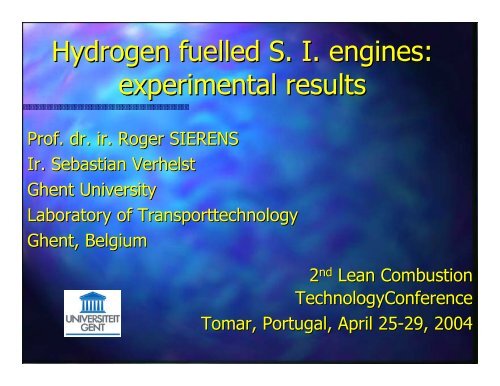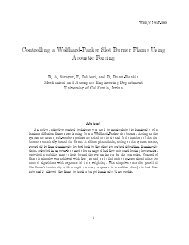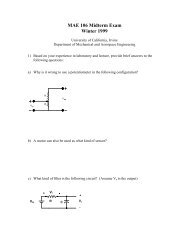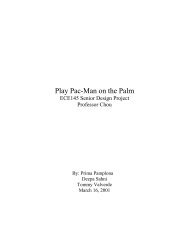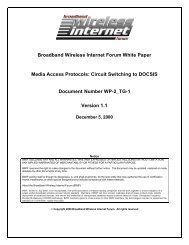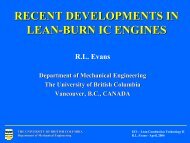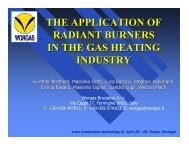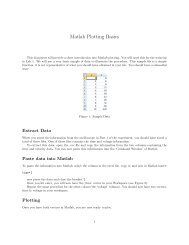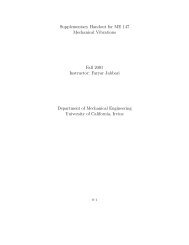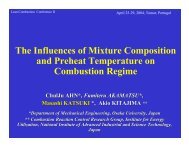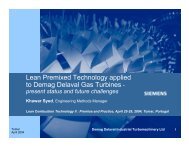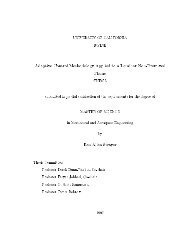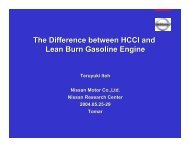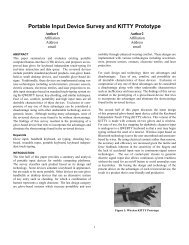Hydrogen fuelled S. I. engines: experimental results
Hydrogen fuelled S. I. engines: experimental results
Hydrogen fuelled S. I. engines: experimental results
- No tags were found...
You also want an ePaper? Increase the reach of your titles
YUMPU automatically turns print PDFs into web optimized ePapers that Google loves.
<strong>Hydrogen</strong> <strong>fuelled</strong> S. I. <strong>engines</strong>:<strong>experimental</strong> <strong>results</strong>Prof. dr. ir. Roger SIERENSIr. Sebastian VerhelstGhent UniversityLaboratory of TransporttechnologyGhent, Belgium2 nd Lean CombustionTechnologyConferenceTomar, , Portugal, April 25-29, 29, 2004
Contents• Introduction• <strong>Hydrogen</strong> engine is “growing up”• Experimental <strong>results</strong> at Ghent university• Simulation• ConclusionsGM 7,4 l V8CFR engineAudi 400 cc engine- natural gas- hydrogen
IntroductionIncentives for a hydrogen economyFocus on use of H 2 in internalcombustion <strong>engines</strong> (ICE): H 2 <strong>fuelled</strong>spark ignition (SI) <strong>engines</strong>
Global Energy Systems TransitionForecasting the age of Energy Gases
Why ICEs? Estimate: 600M motor vehicles→ replace with fuel cell vehicles??→ convert to H 2 ICE! (→(focus on PFI) ICE: proven technology Bi-fuel possible → transition period Simplicity + cost Gain experience with storage and transport
Advantages of H 2 for SI <strong>engines</strong> (1)Wide flammability limits→ Control load by air to fuel ratio→ Wide open throttle operation → ηH 2CH 4gasolineNTP4% 75%5% 15% 1% 7,6%
Advantages of H 2 for SI <strong>engines</strong> (2) High burning velocity for near-stoichiometricmixtures (near λ=1 / φ=1)→ almost constant-volume combustion → η Elsewhere: properties of lean H 2 flames willcause flame acceleration due to cellularity→ no turbulence enhancing methods have to beused (swirl ports etc.) → η
Advantages of H 2 for SI <strong>engines</strong> (3)High octane value: increasedcompression ratio → ηNaturally: very clean emissionsOnly noxious component is NO x
<strong>Hydrogen</strong> engine is ‘growing‘up’ ’ (1)First generation: gas venturi→ low power output: λ min high to avoidbackfire + large volume of combustiblemixture in inlet manifold(backfire: explosion before inlet valvecloses)
<strong>Hydrogen</strong> engine is ‘growing‘up’ ’ (2)Second generation: MPIECU+multipoint sequential injection→ Strategy of late injection: coolingbefore injection→ Cylinder-selective management→ P e,max,H2 : ½ P e,maxe,max, , gasoline
<strong>Hydrogen</strong> engine is ‘growing‘up’ ’ (3)Third generation:EGR + λ=1: NO xturbo/supercharging + intercooling: P e,max→ P e,max,H2 = P e,maxe,max, , gasoline
Specifications of the original diesel engineMarkValmet (Finland)Type420 DNumber of cylinders4 (in line)Bore108 mmStroke120 mmSwept volume4,4 dm³Compression ratio 16:1Maximum power64 kW at 2400 rpmMaximum torque285 Nm at 1500 rpm
Engine Modifications• Spark plugs at the location of the originalinjectors• Electronically controlled ignition• , = 8.7 : 1• Central located gas carburetor (gas venturi)
Backfire Oil control (mimimize(hot deposits) Cooling: adapted water passages, lateinjection strategy, sodium cooled exhaustvalves Ignition system (avoid energy build-upsupsbetween ignitions) + cold spark plugs
Individual pressure curves
Enlargement pressure curvesOf the compression period
Influence of fuelHythane: hydrogen / natural gas mixtureshydrogen – enriched natural gas extension of the lean limit of natural gas8 cylinder GM engine:hydrogen: backfire for 8 < 1.5hythane with 80% hydrogen:no knock – no backfireincrease of power output
• Similar <strong>results</strong> for different fuel mixtures•Ability of hythane :the leaner the higher the hydrogen content
Emissions8 = 1.1 – 1.2minimum UHCmaximum NO X
Situation gasoline S.I. <strong>engines</strong>Multipoint injectionelectronic engine controlConverted for gaseous fuels gas carburetor necessary : multipoint injectionelectronic engine control problem : gaseous injection
Mixture formation systems:• Liquid injection• High pressure gas injection• Low pressure gas injection• Sequential low pressure injection (timed)• Just before inlet valve (port injection)• Multi-point
Lab work (1)GM 7.4l V8750-4000rpm
MPI Delay of introduction: suitable injectors→ H 2 density very low: very large volumes to beinjected in short time + H 2 : low lubricity Currently commercially available(Koltec-Necam,, Siemens, …) ECUs: : allow 1+ injectors to be used per cylinder Injection as close to IVC as possible (backfire)
Lubrication Lubricating oil has to be adapted!H 2 blow-by by attacks VI improvers Change valve seats (cfr(CNG) Crankcase ventilation!Avoid build-up up of explosive mixture
Lab work (2)CFR engine600cc600rpm
NO x (1)500045004000[NOx] (ppm)35003000250020001500100050001 1,2 1,4 1,6 1,8 2 2,2 2,4 2,6λ
NO x (2)Lean-burn strategy: λ>2→ largedecrease in maximum power output EGR+TWC: λ=1 operation, control loadby amount of EGR (very highconcentrations possible, >50%)
18001700CR=8:1; IT=17°bTDCCR=11:1; IT=17°bTDCCR=8:1; IT=5°bTDCP i (W)16001500140013000 5 10 15 20 25 30 35 40EGR (vol%)
2500CR=8:1; IT=17°bTDCCR=11:1; IT=17°bTDC2000NO x (ppm)1500100050000 5 10 15 20 25 30 35 40EGR (vol%)
18001700CR=8:1; IT=17°bTDCCR=11:1; IT=17°bTDCCR=8:1; IT=5°bTDCP i (W)16001500140013001 1,1 1,2 1,3 1,4 1,5 1,6 1,7 1,8 1,9 2λ (-)
40003500CR=8:1; IT=17°bTDCCR=11:1; IT=17°bTDC3000NO x (ppm)250020001500100050001 1,1 1,2 1,3 1,4 1,5 1,6 1,7 1,8 1,9 2λ (-)
18001750lean burn λ=1,12EGR 16,4 Vol%CR=8:1P i (W)17001650160015500 2 4 6 8 10 12 14 16IT (°ca bTDC)
ε = 8:1Injection geometry (1)λ = 2.0IT = 15 °ca
Injection geometry (2)14801460Pi,norm (W)144014201400138013601340T-junctionY-junction45°-junction45°-inverse10 20 30 40 50 60 70 80 90 100IM (° ca)
Injection geometry (3)pcyl (bar)39383736353433323130Y-junctionT-junction45°-junction45°-inverse10 30 50 70 90 110IM (° ca)
Injection geometry (4)Pressure in intake channel
Lab work (3)Audi-NSU400cc1500-5000rpm5000rpm
SimulationExperiments: time and money…Simulation: development of fastcomputer code for optimization of H 2<strong>engines</strong>
Other research:BMW, , Ford
Conclusions H 2 SI engine is near maturity Lab research:- Experimental (engine test benches)MPI system, injection geometry, EGR,backfire, lubrication, …- Simulation: ongoing


